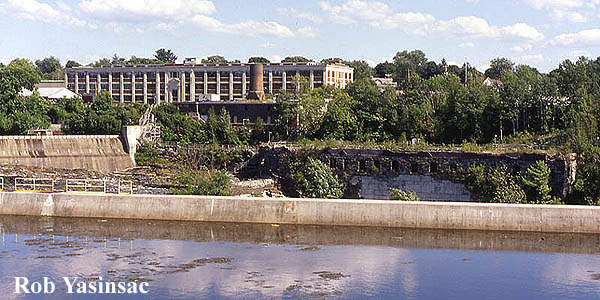
General Electric site from the west, August 27, 2005.
General Electric
Hudson Falls, NY

General Electric site from the west, August 27, 2005.
Many issues have deeply
divided Hudson Valley residents over the centuries, but the problem of pollution
and our response (or lack thereof) seemingly will remain unsolved. Pollution had
a financial impact on those who depended on the Hudson for livelihood -
sewage-like water and inedible fish destroyed small
fishing business in the 20th century. And animals that live in or feed in the
Hudson are still endangered by fouled waters. While the visible water quality has dramatically
improved, an unseen pollutant known as polychlorinated biphenyls (PCBs) remains
in the bottom of the Hudson: PCBs in the riverbed may
lie there for centuries more, compounding the problem. A plan to remove those
sediments has deeply divided political/business interests of the upper valley
and their constituents. Some say the river will "take care of itself"
and bury the PCBs, others believe the contaminated soil must be removed or PCBs
will continue to find their way into the food chain.
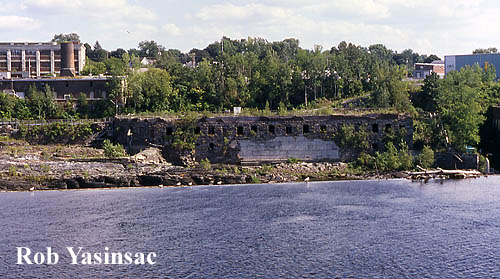
The haunting stone ruin of the Allen Mill that leaked PCBs into
the Hudson River.
The source of this
particular pollution is the General Electric site in Hudson Falls, Washington
County. GE's mid-twentieth century operations were housed what was formerly the Union Bag and Paper
Corporation. The largest mill building, adjacent to the rail line, is also known
as the Fenimore Mill or Fenimore Sulphite Mill. At the old Union Bag and Paper
factory, GE manufactured electrical capacitors using PCBs from 1952 until 1976.
Shortly before ceasing operations at Hudson Falls, GE was cited for polluting
the Hudson due to "corporate abuse and regulatory failure." One year
later, the Environmental Protection Agency outlawed discharges of PCBs in navigable
waters. Unfortunately for the Hudson it was too late. In 1983, the EPA placed a
40-mile stretch of the river on the Federal Superfund list as a toxic waste
site.
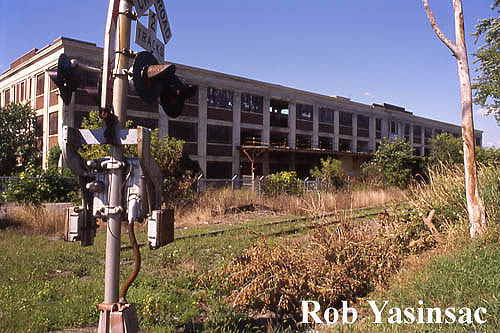
Union Bag and Paper Corporation building from east.
PCBs from the GE factory were not properly contained or disposed of. The PCBs
leaked into the ground and into the bedrock adjoining the Hudson. The bedrock
there is shale, a porous rock lined with fissures. The stone Allen Mill, a
mid-19th century structure, became a repository for the PCBs. In 1991, a wooden
flume gate at the Allen Mill gave way, unleashing PCBs into the Hudson. GE has
made efforts to clean up the Allen Mill site and surrounding area, but debate
continues over the clean up of the Hudson itself. There have been too many
volleys between GE, the EPA and DEC regarding removal of contaminated soil to
list here; resources provided below contain more information. At the latest
(November 2005), GE seems to unwilling to completely dredge the river. A current
plan would leave contaminated soil in the river as long as it is
"capped" with clean fill. The
Hudson River will never be as clean as it once was, though hopefully those
responsible for damaging it will make the fullest efforts to remedy their
errors.
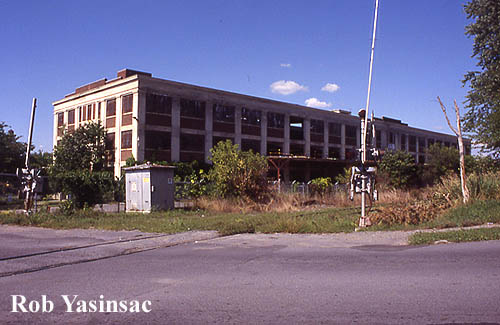
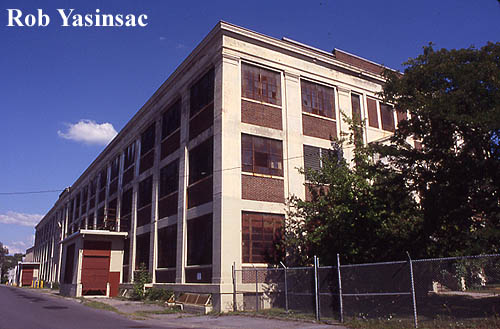
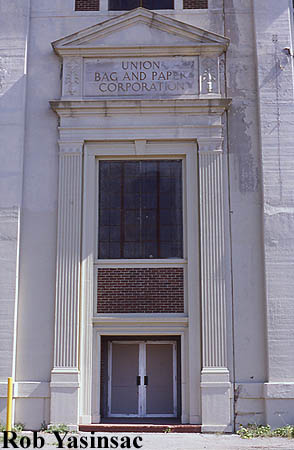
Neo-Classical entrance to Union Bag and Paper Corporation, west front.
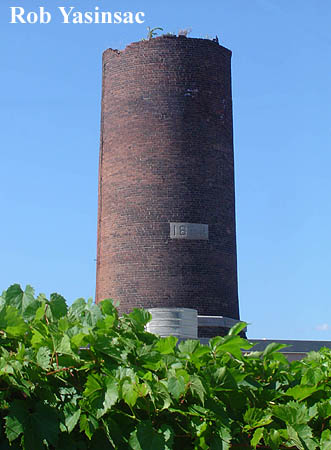
Industrial smokestack, now Romantic ruin.
Links:
Sloop Clearwater:
http://www.clearwater.org/pcbs/index.html
Slide Show at http://www.clearwater.org/pcbs/slideshow/slide1.html
Environmental Protection Agency:
http://www.epa.gov/hudson/actions.htm
General Electric:
Hudson River: http://www.ge.com/en/citizenship/ehs/remedial/hudson/index.htm
Hudson Falls: http://www.ge.com/en/citizenship/ehs/remedial/hudson/project.htm
New York State Department of Environmental Conservation:
http://www.dec.state.ny.us/website/der/projects/gehudsonfalls/
Marist College - Hudson River PCB Timeline
http://www.marist.edu/summerscholars/01/timeline.htm
Yaz’ Hudson
Valley Ruins and Abandoned Buildings, etc.
This page copyright © 2005 by Robert J.Yasinsac.
Reproduction of these photos without the permission of Robert Yasinsac is prohibited.